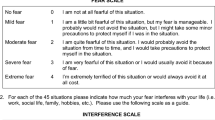Abstract
The responses of 271 outpatients with diagnoses of agoraphobia with panic attacks, panic disorder, generalized anxiety disorder, social phobia, obsessive-compulsive disorder, or depression (major depressive disorder or dysthymic disorder) to the Agoraphobic Cognitions Questionnaire (ACQ) and the Body Sensations Questionnaire (BSQ) were examined. Agoraphobics scored significantly higher than all other groups on fear of body sensations associated with anxiety. In addition, agoraphobics, together with clients with panic disorder, had significantly higher scores on thoughts that physical illness would be caused by their anxiety. All clinical groups scored significantly higher than normal controls on thoughts that their anxiety would lead to social embarrassment or loss of control; there were no significant differences among clinical subjects on this measure, although agoraphobics' scores were higher than those of all other groups. In addition, analyses of data from 364 agoraphobics showed that the ACQ and BSQ predicted an important feature of agoraphobia—namely, self-reported avoidance behavior, even once the common variance of fear of fear with trait anxiety was partialed out. In summary, it appears that fear of fear is an important distinguishing characteristic among clients with anxiety disorders, and one that cannot be reduced to global psychological distress or trait anxiety.
Similar content being viewed by others
References
American Psychiatric Association. (1980).Diagnostic and statistical manual of mental disorders (3rd ed.). Washington, DC: Author.
American Psychiatric Association. (1987).Diagnostic and statistical manual of mental disorders (3rd ed.-rev.). Washington, DC: Author.
Beck, A. T. (1976).Cognitive therapy and the emotional disorders. New York: International Universities Press.
Beck, A. T., & Emery, G. (1985).Anxiety disorders and phobias. New York: Basic Books.
Belfer, P., & Glass, C. (in press). Agoraphobic anxiety and fear of fear: Test of a cognitive-attentional model.Journal of Anxiety Disorders.
Chambless, D. L. (1985a). Agoraphobia. In M. Hersen & A. S. Bellack (Eds.),Handbook of clinical behavior therapy with adults (pp. 49–87). New York: Plenum Press.
Chambless, D. L. (1985b). The relationship of severity of agoraphobia to associated psychopathology.Behaviour Research and Therapy, 23 305–310.
Chambless, D. L., Caputo, G. C., Bright, P., & Gallagher, R. (1984). Assessment of fear of fear in agoraphobics: The Body Sensations Questionnaire and the Agoraphobic Cognitions Questionnaire.Journal of Consulting and Clinical Psychology, 52 1090–1097.
Chambless, D. L., Caputo, G. C., Jasin, S. E., Gracely, E. J., & Williams, C. (1985). The Mobility Inventory for Agoraphobia.Behaviour Research and Therapy, 23 35–44.
Chambless, D. L., & Gracely, E. J. (1988). Prediction of outcome following in vivo exposure treatment of agoraphobia. In I. Hand & H.-U. Wittchen (Eds.),Panic and phobias. II. Berlin: Springer-Verlag.
Chambless, D. L., & Mason, J. (1986). Sex, sex-role stereotyping and agoraphobia.Behaviour Research and Therapy, 24 231–235.
Clark, D. M. (1986). A cognitive approach to panic.Behaviour Research and Therapy, 24 461–470.
Craske, M. G., Rachman, S. J., & Tallman, K. (1986). Mobility, cognitions, and panic.Journal of Psychopathology and Behavioral Assessment, 8 199–210.
Goldstein, A. J., & Chambless, D. L. (1978). A reanalysis of agoraphobia.Behavior Therapy, 9 47–59.
Jackard, J., Becker, M. A., & Wood, G. (1984). Pairwise multiple comparison procedures: A review.Psychological Bulletin, 96 589–596.
Marks, I. M. (1970). The classification of phobic disorders.British Journal of Psychiatry, 116 377–386.
McNally, R. J., & Lorenz, M. (1987). Anxiety sensitivity in agoraphobics.Journal of Behavior Therapy and Experimental Psychiatry, 18 3–11.
Reiss, S. (1987). Theoretical perspectives on fear of anxiety.Clinical Psychology Review, 7 585–596.
Reiss, S., Peterson, R. A., Gursky, D. M., & McNally, R. J. (1986). Anxiety sensitivity, anxiety frequency and the prediction of fearfulness.Behaviour Research and Therapy, 24 1–8.
Spielberger, C., Gorsuch, A., & Lushene, R. (1970).The State-Trait Anxiety Inventory. Palo Alto, CA: Consulting Psychologists Press.
Spitzer, R., & Williams, J. B. W. (1983).Instructional manual for the Structured Clinical Interview for DSM-III-R. New York: Biometrics Research Department, New York State Psychiatric Institute.
Weekes, C. (1976).Simple, effective treatment for agoraphobia. New York: Hawthorn.
Author information
Authors and Affiliations
Additional information
The authors wish to thank Aaron T. Beck, Gary Brown, and Gail Steketee, whose cooperation in data collection made this study possible; Nazareth Pantaloni, for his assistance in data analysis; and Carol Glass, for her helpful comments on an earlier draft of this paper.
Rights and permissions
About this article
Cite this article
Chambless, D.L., Gracely, E.J. Fear of fear and the anxiety disorders. Cogn Ther Res 13, 9–20 (1989). https://doi.org/10.1007/BF01178486
Issue Date:
DOI: https://doi.org/10.1007/BF01178486




